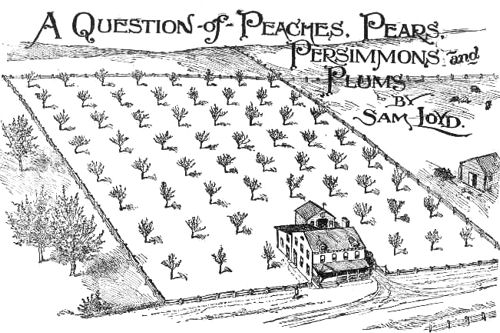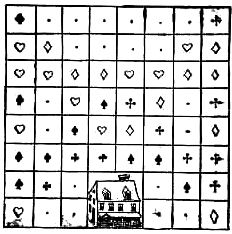



I ONCE KNEW AN ECCENTRIC old gardener who had a hobby for setting out his young fruit trees according to a secret code, so that no one but himself could locate the several varieties of trees in an orchard. He gave as a reason that he was engaged in experimental grafting and did not care to let visitors or even those in his employ into the secrets of his craft.
He was continually inventing and devising new methods for concealing the location of trees which were undergoing certain experimental grafting, and, as a matter of fact, used to put away the chart or clue to the secret, even from himself, so as to see if the developments of his experiments would he sufficiently marked to disclose their locality.
The last time I saw him he had just set out sixty young trees adjoining his house, as shown in the accompanying picture, and it may be of interest to mention that these sixty trees were what is known as quince stock, upon which the different varieties of fruits are grafted. It had always been a fad with him to set out ten trees of a kind at one time, but to scatter them in different parts of the orchard, located according to some sort of secret system, which would place ten trees in five rows of four in a line. It is quite a pretty little puzzle to lay out ten trees in such a way that there will be five rows of four in a line, and a still more difficult feat to duplicate the trick so that, one group of trees will not interfere with another of a different species.
He always maintained that the principle might be carried still further, so as to bring in other groupings, and asked me to work it into a puzzle to see if any of our puzzle experts could help him out.
The problem, therefore, is to see how many groupings of different kinds of fruit can be located in the orchard as shown. There must be ten trees of each kind of fruit, so arranged that there will be five rows of four-in-a-line of each fruit.
I have suggested the names of peaches, pears, persimmons, and plums, hoping that the plan of the four groupings may be discovered.
In working out your solution mark out a diagram upon a sheet of white paper, dots representing the trees, and each tree marked with the name of the fruit; or the solution may be shown by writing in the names under the trees in the picture. Of course, in allowing the groupings of the four sets it would require but forty of the sixty trees shown—the sixty trees in the picture merely show where the selected forty may be placed.
Many of our puzzlists succeeded in placing ten peach trees so as to form five rows of four-in-line. Some found it an easy matter to locate the peach tree? properly, and a few succeeded in getting the persimmons in line, but the plum question was too difficult for the average puzzlist to master.
Utilizing spades, clubs, hearts and diamonds to represent the four varieties of fruit and the dots to the remaining quinces, the accompanying diagram gives the answer to this remarkably difficult puzzle.

2.
What does a man love more than life,
Hate more than death or mortal strife;
That which contented men desire.
The poor have, and the rich require;
The miser spends, the spendthrift saves.
And all men carry to their graves.
Nothing.
3.
Why is a chicken-pie like a gunsmith's shop? Because it contains fowl-in pieces.
When do your teeth usurp the functions of the tongue? When they are chattering.
Why is Buckingham Palace the cheapest palace ever built? Because it was built for one sovereign and furnished for another.
Which is heavier a half or a full moon? The half, because the full moon is as light again.
When does a cow become real estate? When turned into a meadow.
Why is it impossible to pick the best horse in a race? Because there is always a bettor.
[Page 126]